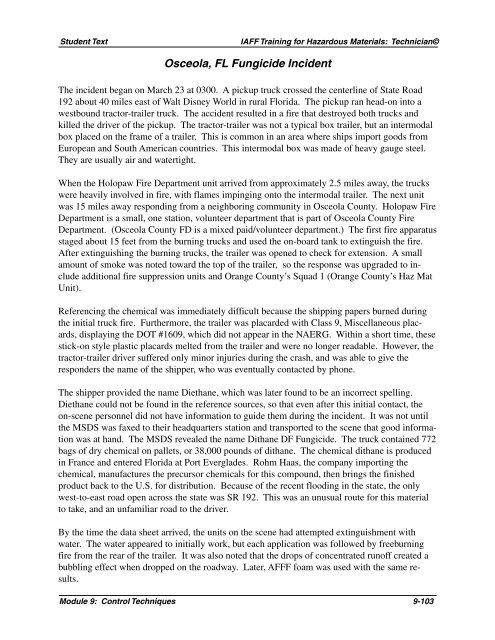Module 9: Control Techniques - International Association of Fire ...
Module 9: Control Techniques - International Association of Fire ...
Module 9: Control Techniques - International Association of Fire ...
You also want an ePaper? Increase the reach of your titles
YUMPU automatically turns print PDFs into web optimized ePapers that Google loves.
Student Text IAFF Training for Hazardous Materials: Technician©<br />
Osceola, FL Fungicide Incident<br />
The incident began on March 23 at 0300. A pickup truck crossed the centerline <strong>of</strong> State Road<br />
192 about 40 miles east <strong>of</strong> Walt Disney World in rural Florida. The pickup ran head-on into a<br />
westbound tractor-trailer truck. The accident resulted in a fire that destroyed both trucks and<br />
killed the driver <strong>of</strong> the pickup. The tractor-trailer was not a typical box trailer, but an intermodal<br />
box placed on the frame <strong>of</strong> a trailer. This is common in an area where ships import goods from<br />
European and South American countries. This intermodal box was made <strong>of</strong> heavy gauge steel.<br />
They are usually air and watertight.<br />
When the Holopaw <strong>Fire</strong> Department unit arrived from approximately 2.5 miles away, the trucks<br />
were heavily involved in fire, with flames impinging onto the intermodal trailer. The next unit<br />
was 15 miles away responding from a neighboring community in Osceola County. Holopaw <strong>Fire</strong><br />
Department is a small, one station, volunteer department that is part <strong>of</strong> Osceola County <strong>Fire</strong><br />
Department. (Osceola County FD is a mixed paid/volunteer department.) The first fire apparatus<br />
staged about 15 feet from the burning trucks and used the on-board tank to extinguish the fire.<br />
After extinguishing the burning trucks, the trailer was opened to check for extension. A small<br />
amount <strong>of</strong> smoke was noted toward the top <strong>of</strong> the trailer, so the response was upgraded to include<br />
additional fire suppression units and Orange County’s Squad 1 (Orange County’s Haz Mat<br />
Unit).<br />
Referencing the chemical was immediately difficult because the shipping papers burned during<br />
the initial truck fire. Furthermore, the trailer was placarded with Class 9, Miscellaneous placards,<br />
displaying the DOT #1609, which did not appear in the NAERG. Within a short time, these<br />
stick-on style plastic placards melted from the trailer and were no longer readable. However, the<br />
tractor-trailer driver suffered only minor injuries during the crash, and was able to give the<br />
responders the name <strong>of</strong> the shipper, who was eventually contacted by phone.<br />
The shipper provided the name Diethane, which was later found to be an incorrect spelling.<br />
Diethane could not be found in the reference sources, so that even after this initial contact, the<br />
on-scene personnel did not have information to guide them during the incident. It was not until<br />
the MSDS was faxed to their headquarters station and transported to the scene that good information<br />
was at hand. The MSDS revealed the name Dithane DF Fungicide. The truck contained 772<br />
bags <strong>of</strong> dry chemical on pallets, or 38,000 pounds <strong>of</strong> dithane. The chemical dithane is produced<br />
in France and entered Florida at Port Everglades. Rohm Haas, the company importing the<br />
chemical, manufactures the precursor chemicals for this compound, then brings the finished<br />
product back to the U.S. for distribution. Because <strong>of</strong> the recent flooding in the state, the only<br />
west-to-east road open across the state was SR 192. This was an unusual route for this material<br />
to take, and an unfamiliar road to the driver.<br />
By the time the data sheet arrived, the units on the scene had attempted extinguishment with<br />
water. The water appeared to initially work, but each application was followed by freeburning<br />
fire from the rear <strong>of</strong> the trailer. It was also noted that the drops <strong>of</strong> concentrated run<strong>of</strong>f created a<br />
bubbling effect when dropped on the roadway. Later, AFFF foam was used with the same results.<br />
<strong>Module</strong> 9: <strong>Control</strong> <strong>Techniques</strong> 9-103
















